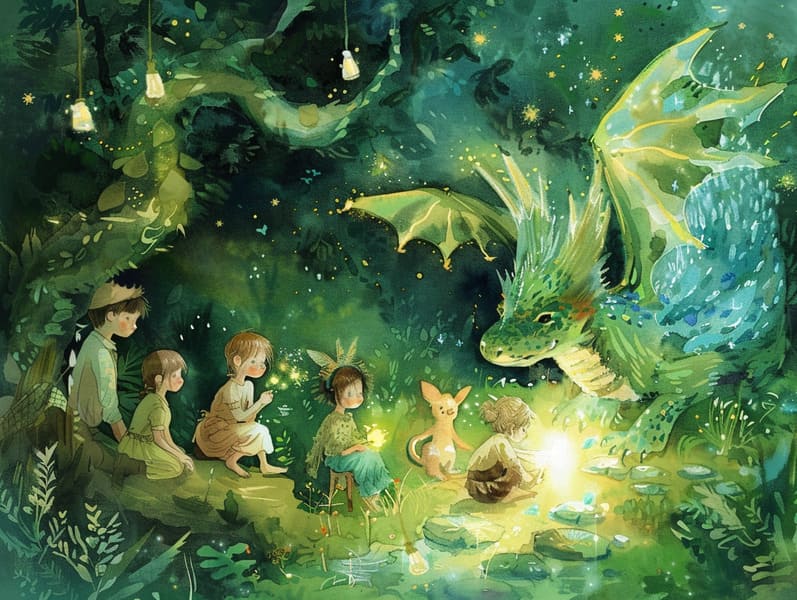The Formation of Timeless Fairy Tales and Its Unchanging Elegance.
The Formation of Timeless Fairy Tales and Its Unchanging Elegance.
Blog Article

Best fairy tales have legendary status. These stories have been shared from one generation to the next millennia before they were ever put on paper. They emerged from a variety of societies, including Eastern traditions. They were initially shared among adults, often carrying themes and messages relevant to the societal norms and beliefs of the time.
The Brothers Grimm, Jacob and Wilhelm, were among the first to assemble many of these beloved narratives. Their anthology, "Grimm's Fairy Stories," included narratives like "The True Bride," "The Bread Crumb Trail," and "The True Story of Snow White," which have since become essentials in the world of iconic fairy tales. Similarly, Hans Christian Andersen's delightful tales, such as "The Mermaid," and "The Little Duckling," have enchanted hearts worldwide, ensuring their place in the pantheon of timeless fairy tales.
Though they are centuries old, fairy tales remain as impactful as ever, especially as children's bedtime stories. These enchanting tales are now available in numerous formats, including vibrantly illustrated books, whimsical animations, and free fairy tales online.
Their persistent charm can be traced to several fascinating points:
Moral Lessons: Classic fairy tales often impart important moral lessons. Fairy tales like "The Shepherd Boy and the Wolf" teach the merit of truth, while "The Tortoise and the Hare" point out the benefits of determination and humbleness. These tales offer kids clear distinctions between virtue and vice, developing their moral compass in a gentle yet impactful way.
Kindness and Comprehension: Old fairy tales frequently showcase beings facing difficulties and adversities, encouraging kids to comprehend with their struggles and cheer for their triumphs. For instance, "Beauty and the Beast" teaches us the virtue of looking beyond appearances to realize the true being of a character, developing understanding and perception.
Cultural Comprehension: Many fairy tales are deeply ingrained in the cultural contexts from which they arose. Exploring these stories can provide enlightening views into different social structures, fostering a sense of cultural understanding and awareness.
Creativity and Imagination: The magical elements in traditional fairy tales—magical beings—enhance children’s fantastical thinking. These tales guide readers to extraordinary realms, fostering fantastical thinking and a sense of curiosity that endures a lifetime.
Ancient fairy tales are not only captivating but also illuminating. They serve as mesmerizing tools in advancing various mind and heart abilities in the young. When traditional fairy tales are voiced, they improve language proficiency by showing new phrases and complex sentence structures. This practice also fosters listening abilities and attention, as children track the narrative, enthusiastic to see what happens next.
Furthermore, deliberating the themes and characters of classic fairy tales can advance thought processes and reasoning skills. Young ones are shown to find patterns, expect results, and make sense of cause and effect. These conversations also help little ones utter their thoughts and feelings, contributing to their emotional intelligence.
In today’s high-tech era, the availability of online fairy tales has made these stories more obtainable than ever. Web-based platforms and apps extend ample collections of classic fairy tales that can be experienced or listened via anytime, anywhere. Fairy tales read out loud are particularly prevalent, sharing an engaging way for little ones to engage with these magical stories. Voice books and spoken videos transport characters and settings to life, often complemented by whimsical background sounds and music that augment the tale journey.
The persistent attraction of traditional fairy tales lies in their ability to alter to current eras while keeping hold of their underlying messages. Contemporary renditions of these fairy tales often present more representative figures and modern settings, making them pertinent to today’s audience. However, the underlying themes of valour, understanding, and truth remain unchanged, continuing to resonate with listeners of all ages.
Traditional fairy tales also offer a sense of peace and predictability. They bequeath a tidy narrative with a straightforward beginning, middle, and end, often finishing with the resolution of conflicts and the triumph of morality over wickedness. This regularity can be encouraging for kids, granting a sense of steadfastness in an unpredictable world.
Classic fairy tales continue to bewitch and edify new generations, maintaining their wonder and significance in modern society. As bedtime stories for kids, they present a perfect blend of charm and enlightenment, encouraging moral values, empathy, and creativity. The prevalence of online storybooks and the likability of fairy tales recited make sure that these timeless tales remain available to new generations.
By retaining and relating these fairy tales, we continue to revere the rich tapestry of inventiveness and cultural heritage. Whether you are browsing a colorful picture book, viewing a cyber collection, or listening via an read-aloud book, the fascination of Grimm's fairy tales is always within reach. These narratives demonstrate of the enduring presence of tales and its ability to bond us across epochs and places.
If you are discovering a colorful picture book, delving into a cyber library, or listening to an read-aloud story, the enchantment of timeless website fairy tales is always within reach.
These fairy tales highlight of the consistent spell of narratives and its ability to bind us across time and space, forging a link that delights and instructs alike.